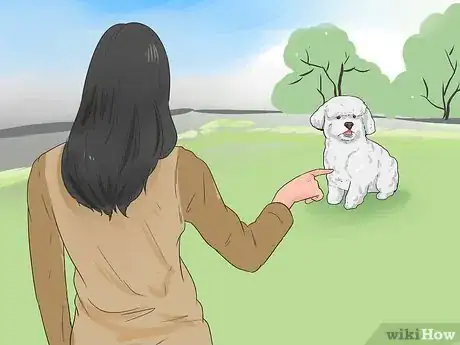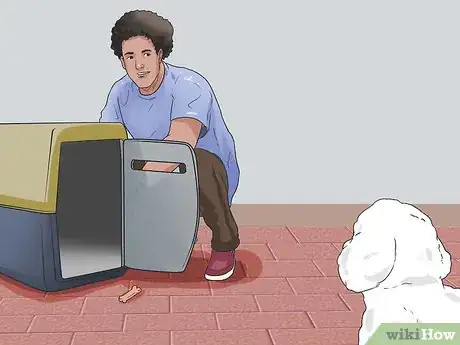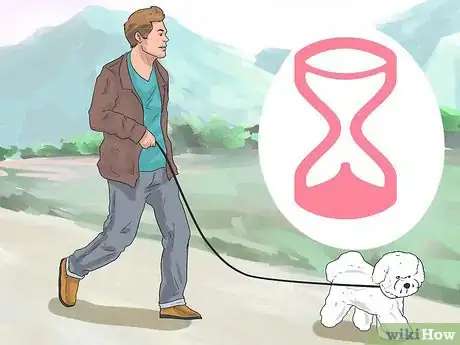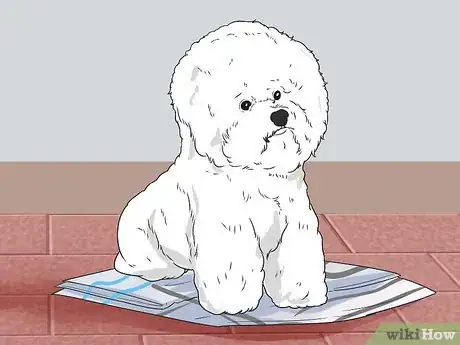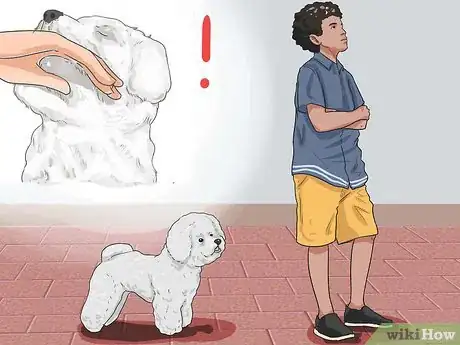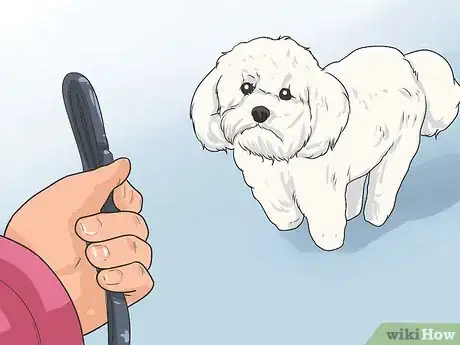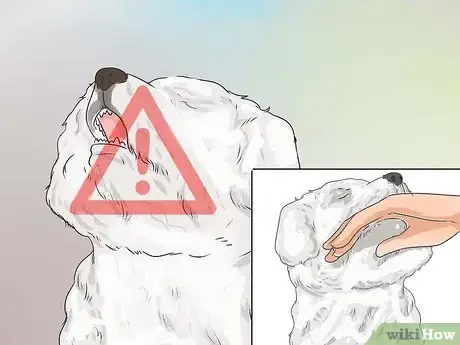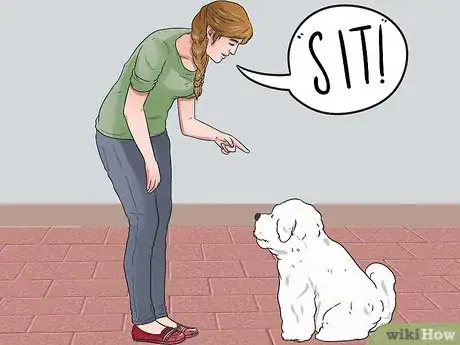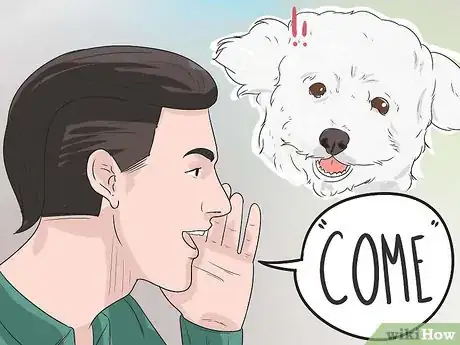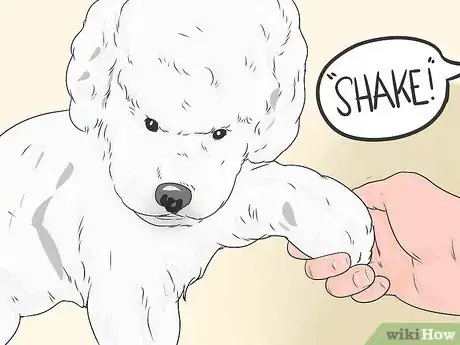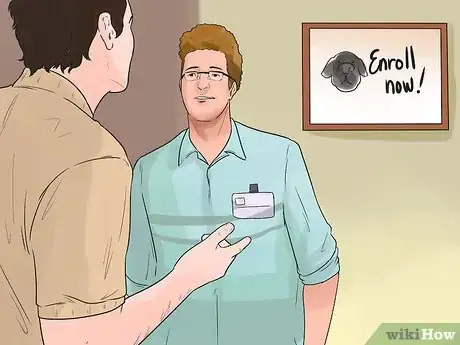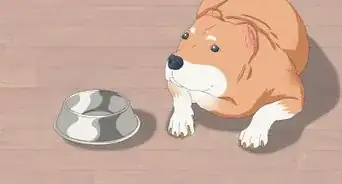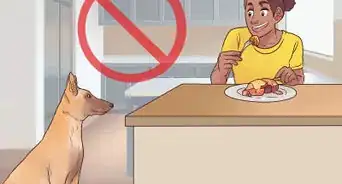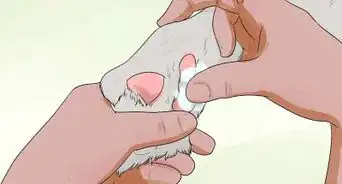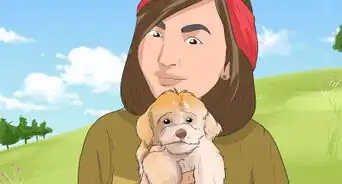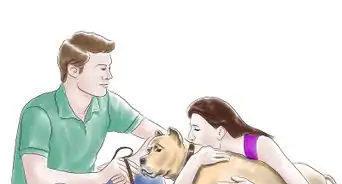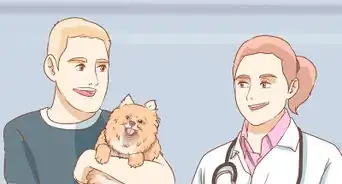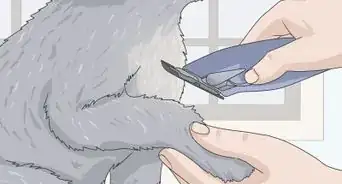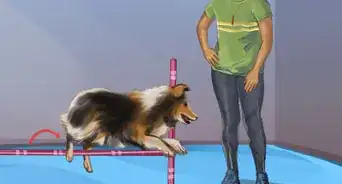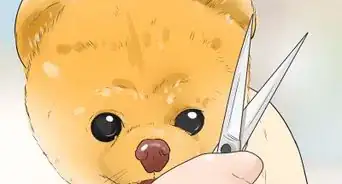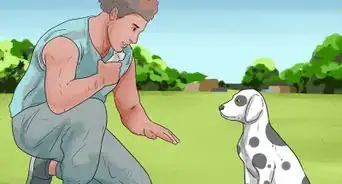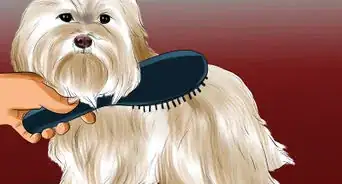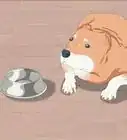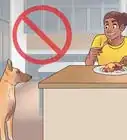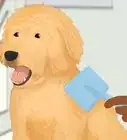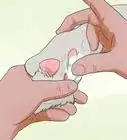This article was co-authored by Ty Brown. Ty Brown is a Dog Behaviorist and Trainer and the Owner of Ty the Dog Guy, a business that provides dog training through digital resources (podcasts, web series, and online courses) along with in-person dog training. Ty has over 17 years of experience in dog training and specializes in both mitigating unruly pet behavior and service dog training. Ty has been awarded the "Best of State Award" for dog training in Utah ten times and his work has been featured in ABC, NBC, CBS, Spike TV, and Entrepreneur Magazine.
There are 7 references cited in this article, which can be found at the bottom of the page.
wikiHow marks an article as reader-approved once it receives enough positive feedback. In this case, 87% of readers who voted found the article helpful, earning it our reader-approved status.
This article has been viewed 240,515 times.
Bichon Frises are highly trainable dogs who are driven by a desire to please their owners. However, for housebreaking especially, Bichons can be stubborn and difficult to train. A combination of consistency, dedication, and positive reinforcement are necessary to properly train your Bichon Frise.
Steps
Housebreaking Your Bichon Frise
-
1Start house breaking immediately. House breaking starts as soon as you get home, by putting the dog on their toilet spot and praising it when it goes.[1] This is the first step toward training your Bichon Frise.
-
2Proceed with crate training. Bichon Frises are quick learners in most aspects, but can be notoriously difficult to potty train.
- Many owners are wary of crate training as they don't want to confine their pets. However, dogs are den animals and do not mind being occasionally confined to a crate. Periodically crating a dog, for road trips or overnight vet visits, is inevitable. It's good idea to get your pet used to a crate regardless of potty training.
- Try to make entering the crate a treat rather than a punishment. Keep it comfortable, with bedding and offer your Bichon a small treat before it enters its crate. Start by closing the door for just a few seconds before opening it. Then, move on to longer and longer amounts of time until your dog feels comfortable in it.[2]
- If you have a puppy, it might occasionally have an accident in its crate overnight. Most puppies should be able to sleep soundly in their crate without urinating or defecating after three months. If your Bichon is still having bathroom problems after 3 months, talk to a vet to rule out underlying medical issues.
- You'll have to keep your Bichon in the crate any time it is not supervised. When you go to bed, go out, or are busy with household chores, your Bichon will need to be in its crate. Play with it for 10 to 15 minutes before putting it in the crate so it's relaxed and does not have pent up energy.
- However, it is important not to treat the crate as a "cage" or "prison" and to keep use to a minimum. If necessary, when you are home keep the dog on a lead so you can keep an eye on it and take it outside to toilet as soon as you spot signs of your dog wanting to toilet.
Advertisement -
3Take your Bichon Frise out every 2 to 3 hours. If you have a puppy, take it out even more frequently (every 20 - 30 minutes). You need to get your Bichon on a bathroom schedule and teach it outside is the proper place to do its business.[3] When you're first housebreaking your Bichon, let it out every 2 to 3 hours.
- Ideally, you should let your Bichon out 10 to 15 minutes after it eats. This is when it's most likely to need to use the bathroom. Praise it when it goes outside and otherwise encourage the behavior. This can be done by allowing the Bichon to walk around, as movement stimulates bowel movements. You can also take it to a spot in the yard you've seen other dogs use as a bathroom. It will recognize the scent and is more likely to go there. Then, when it toilets make a big fuss, praise it, and offer a treat.
- Keep a diary for the first couple of weeks. Take notes of when and where your Bichon went outside and any accidents that occur. Write down times. You want to get a sense of your Bichon's bathroom schedule. Planning walks and outings when you know it's more likely to go can help teach it to associate the outdoors with using the bathroom.
- Until your Bichon is accident free in the house, you will have to continue crating it while you're gone, sleeping, or busy.
-
4Try paper training if your Bichon is particularly stubborn about housebreaking. Bichons, and small dogs in general, can be difficult to house train. If you keep having problems with your dog going inside, despite following proper training protocol, you might want to consider paper training your Bichon.
- Paper training means teaching your Bichon it can go inside but only if it uses newspaper, pads sold for paper training purposes, or other absorbent material you can leave around the house.
- You should only use positive reinforcement to paper train your Bichon. Praise your dog when it uses the proper materials indoors and correct it when it does not. Scolding should be done in a deep, authoritarian voice. Never get hysterical and resort to yelling. This only frightens and confuses a dog.
- If you have a male, paper training is not advised. Males tend to have more trouble differentiating between appropriate and inappropriate places to urinate than females and are more likely to struggle with paper training.
Correcting Bad Behaviors
-
1Teach your Bichon Frise not to bite. Biting can be a problem with Bichons. They are a friendly breed, so the biting is usually a non-aggressive form of play. However, the dog might not realize biting can be painful to humans. It's important that you train this behavior out of your dog, especially if you have young children.
- Teach your kids to use the "Be a Tree" approach. This means standing still, with limbs held at your side, and avoiding eye contact with the dog. Bichons bite for a variety of reasons, whether it's to assert authority or an attempt to play. If the behavior is not getting a response, they will grow bored and stop.[4]
- If you have young children, especially toddlers, supervise their interaction with your Bichon. In particular, do not let your child interrupt a Bichon while it is eating, playing with its toys, or drinking water. If the dog becomes territorial, it might bite. If his resources are frequently threatened it might learn to habitually engage in biting. Until your child is old enough to respect a dog's boundaries, supervise any interactions.[5]
- Positive and negative reinforcement are a great means of training a Bichon not to bite. When a Bichon is out of its crate, supervise it at all times. If you notice biting, correct the behavior immediately with a stern "No." If your Bichon bites during play, ignore it for a 10-15 seconds to show that biting ends play time.[6]
- Redirecting a Bichon's biting tendencies is also an effective means of curbing biting. When a Bichon nibbles on hands or fingers, immediately place a toy or a bone in its mouth instead. This teaches it biting is okay, as long as it's done to its toys and snacks and not its people.[7]
- Biting should never be encouraged, even in play. A Bichon is not a dog you should wrestle or otherwise rough house with as this leads to timid and even aggressive behaviors.
-
2Practice good leash manners. Bichons can be excellent walking companions, but like all dogs they do need basic leash training.
- Make sure your Bichon is familiar and comfortable in his collar, especially if it's a puppy. A lightweight leather collar is ideal for a Bichon. It might take your dog a bit to get used to wearing the collar, so take it off when your dog is unsupervised until it's used to it.[8]
- Introduce your Bichon to the leash slowly. Allow your dog to sniff it and get familiar with it before attaching it to the collar. Once your dog is familiar, you can begin walking it.[9]
- Start small. Just walk the Bichon around the house. Praise it if it walks by your side on a loose leash. If it pulls, do not pull the leash back. Not only can this strain a Bichon's neck, it reinforces the behavior by giving the dog attention for acting out. You need to show your Bichon that pulling on the leash will result in getting nowhere. Simply stop walking and call your Bichon back to you.[10]
- Once your Bichon is well behaved inside, you can start taking it for short walks around the neighborhood. A 15 to 20 minute walk a few times a day is ideal and will give your Bichon enough time to adapt to walking on a leash.[11]
-
3Be aware of small dog syndrome. Small dog syndrome can be a problem with smaller breeds like Bichon Frises. Owners do not discipline their dogs for behaviors like barking and biting and attempt to protect small dogs from the world. What results is improper socialization that leads to a number of behavioral problems.[12]
- Make sure your Bichon feels happy, safe, and confident when near larger dogs. People often pick up small dogs in the presence of bigger dogs, or yell loudly when they're approached by big dogs. Both behaviors teach Bichons big dogs should be feared, which can lead to biting, yipping, and other territorial behaviors.[13]
- If your Bichon seems nervous around big dogs, talk to it calmly and give it treats and praise if is calm. However, do not praise your dog if it is not calm and do not continue to praise it once a big dog has passed. This will lead to your dog becoming spoiled and expecting extra attention in response to day-to-day circumstances.[14]
- Remember, small dogs should be disciplined for the same behaviors as large dogs. People often let nipping, barking, and aggression go unchecked in small dogs because they believe they're less likely to cause physical harm. However, a small dog could easily lash out at a young child and their bites can be hard enough to require stitches. Do not let your Bichon's size determine how you treat it and never give it a pass for aggressive behaviors.[15]
Teaching Basic Commands
-
1Start with "sit" and "lie down." Sit and lie down lay out the groundwork for nearly every command a dog can perform. To shake paws, a dog must be sitting. To roll over, a dog must lie down. When you begin teaching your Bichon Frise, start with "sit" and "lie down" as these are foundational commands.
- Begin with sit. To teach sit, stand up, say sit, and then use a treat and draw an arc over the puppy' s head so that as its head goes up its bottom goes down.The instant your Bichon sits, praise it with treats and other rewards.[16]
- Use hand motions once your dog understands to sit when you say sit. Put your hand forward and gesture for your dog to sit down. As your dog begins to master the command, you can phase out hand gestures. Try to repeat the command 10 or 15 times a day until your Bichon learns to sit without hand gestures of constant reinforcement in the form of treats or praise. Ideally, you should be able to get your Bichon to sit when it's being disruptive with guests or before you take him for a walk.
- You can smoothly transition from sit to lie down by commanding your Bichon to sit. Then, while saying "lie down," use a treat to lure it into a lying position. Get your dog to sit then hold the treat at floor level but slowly move it away from him so that your dog stretches and lies down to get it. Praise your dog with treats and attention as soon as it's lying down. Much like you taught sit, practice until you can gradually phase out rewards and hand gestures.
-
2Teach your Bichon to come. Come is an important command every dog should learn quickly. Knowing to come when called can prevent accidents and can allow your dog to have greater freedom in certain situations.
- Your goal in teaching "come" is to get your dog to go to you upon hearing the command, regardless of what else is going on. This can be difficult, but with dedication and patience it's achievable.[17]
- Always praise your dog when they return to you upon hearing the command. Never punish them, even if you were calling them back because it was misbehaving. You don't want your dog to associate coming to you with any negative consequences.[18]
- You can teach come by giving your dog positive reinforcement every time it obeys. Provide treats, praise, or access to a favorite toy or bed. Come should be a positive sound for your dog, something it looks forward to hearing. Practice several sets of "come here," making your dog perform the command 15 to 20 times. Doing 3 to 4 sets a day should eventually solidify the behavior in your dog. Once your dog has followed the command, allow it to return to play. This will teach it that "come" doesn't always mean play time's over.[19]
- Never let your Bichon off its leash in public until it has mastered the "come" command.[20]
-
3Move on to other basic commands. Bichons are a highly trainable breed. Once you've mastered behaviors like sit, lie down, and come, you can move on to other basic commands.
- It's sometimes easy to watch for behaviors you can observe and reinforce with a command. Watch for the desired behaviors and then praise them. For example, if you want to teach your Bichon to "speak" say "speak" when it barks, and praise it. Make sure that this is not in response to disruptive barking, such as barking at other dogs or people.[21]
- Consequences need to be immediate as dogs live in the present. If you want your Bichon to beg on cue, and you see it on its hind legs, say "beg" and immediately reward it with food or praise.[22]
- The best way to teach certain behaviors is by simply watching for them, but other behaviors can be maneuvered the way you taught "sit" and "lie down." For example, if you want your Bichon to shake you can physically move its paw towards you while saying "shake" or "give me a paw." Reward it as soon as its paw hits your hand. Eventually, your dog should pick up on the fact that it needs to lift its hand when you say "shake."[23]
- Once the dog has learned what verbal cues signify what behaviors, practice the desired behavior 15 to 20 minutes a day. This will solidify the connection and get your dog to perform on cue when needed.[24]
- Many owners believe they have to behave like an alpha dog. While your Bichon should understand you're in charge, never engage in disciplinary behaviors like rolling a dog on its side, pinching his neck, or other physical forms of punishments. Dogs do not actually respond to this and it can foster feelings of fear. A better way to assert authority is by making your dog understand his schedule is on your terms. Make your dog sit before putting on its leash for a walk. Make it lie down before you place food in its bowl.[25]
-
4Look into more elaborate training opportunities. Bichons are highly trainable, and can easily get beyond the basics. If you're interested in dog training, there are a variety of paths to teach your dog more elaborate skills.
- Consider enrolling in an advanced training class once your dog knows the basics of sit, lie down, and come here. A professional trainer can help you teach your dog more elaborate tricks and, as an added bonus, training is a great way to socialize your Bichon. Your dog will learn how to behave appropriately in the presence of multiple different types of dogs.
- Bichons skill sets are not limited to party tricks. Many owners enjoy professional agility training with their Bichons. Look into agility courses in your area. You can compete at shows, sometimes for cash prizes, and it's a great hobby that fosters a healthy, happy relationship between you and your dog.
- Bichons are also excellent therapy and/or hospital dogs. If you're interested in getting your Bichon certified for hospital or therapy work, look into programs available in your area. Bichons have a naturally friendly personality and love people. Having your dog interact with sick people, or help those with mental or physical disabilities, can be an extremely rewarding endeavor.
Expert Q&A
Did you know you can get expert answers for this article?
Unlock expert answers by supporting wikiHow
-
QuestionCan you delay potty training a dog?
 Ty BrownTy Brown is a Dog Behaviorist and Trainer and the Owner of Ty the Dog Guy, a business that provides dog training through digital resources (podcasts, web series, and online courses) along with in-person dog training. Ty has over 17 years of experience in dog training and specializes in both mitigating unruly pet behavior and service dog training. Ty has been awarded the "Best of State Award" for dog training in Utah ten times and his work has been featured in ABC, NBC, CBS, Spike TV, and Entrepreneur Magazine.
Ty BrownTy Brown is a Dog Behaviorist and Trainer and the Owner of Ty the Dog Guy, a business that provides dog training through digital resources (podcasts, web series, and online courses) along with in-person dog training. Ty has over 17 years of experience in dog training and specializes in both mitigating unruly pet behavior and service dog training. Ty has been awarded the "Best of State Award" for dog training in Utah ten times and his work has been featured in ABC, NBC, CBS, Spike TV, and Entrepreneur Magazine.
Dog Trainer
-
QuestionHow do you crate train a dog?
 Ty BrownTy Brown is a Dog Behaviorist and Trainer and the Owner of Ty the Dog Guy, a business that provides dog training through digital resources (podcasts, web series, and online courses) along with in-person dog training. Ty has over 17 years of experience in dog training and specializes in both mitigating unruly pet behavior and service dog training. Ty has been awarded the "Best of State Award" for dog training in Utah ten times and his work has been featured in ABC, NBC, CBS, Spike TV, and Entrepreneur Magazine.
Ty BrownTy Brown is a Dog Behaviorist and Trainer and the Owner of Ty the Dog Guy, a business that provides dog training through digital resources (podcasts, web series, and online courses) along with in-person dog training. Ty has over 17 years of experience in dog training and specializes in both mitigating unruly pet behavior and service dog training. Ty has been awarded the "Best of State Award" for dog training in Utah ten times and his work has been featured in ABC, NBC, CBS, Spike TV, and Entrepreneur Magazine.
Dog Trainer The goal is to make the crate as comfortable as possible so your dog will make a positive association with it. Give your dog a treat before it goes in its crate. Start by closing the door for just a few seconds at a time. Then, move on to longer amounts of time until your dog feels totally comfortable and relaxed in its crate.
The goal is to make the crate as comfortable as possible so your dog will make a positive association with it. Give your dog a treat before it goes in its crate. Start by closing the door for just a few seconds at a time. Then, move on to longer amounts of time until your dog feels totally comfortable and relaxed in its crate. -
QuestionAre Bichon Frise aggressive?
 Pippa Elliott, MRCVSDr. Elliott, BVMS, MRCVS is a veterinarian with over 30 years of experience in veterinary surgery and companion animal practice. She graduated from the University of Glasgow in 1987 with a degree in veterinary medicine and surgery. She has worked at the same animal clinic in her hometown for over 20 years.
Pippa Elliott, MRCVSDr. Elliott, BVMS, MRCVS is a veterinarian with over 30 years of experience in veterinary surgery and companion animal practice. She graduated from the University of Glasgow in 1987 with a degree in veterinary medicine and surgery. She has worked at the same animal clinic in her hometown for over 20 years.
Veterinarian
References
- ↑ Ty Brown. Dog Trainer. Expert Interview. 4 June 2020.
- ↑ Ty Brown. Dog Trainer. Expert Interview. 4 June 2020.
- ↑ Ty Brown. Dog Trainer. Expert Interview. 4 June 2020.
- ↑ http://cambeas.com/puppy-biting/
- ↑ http://cambeas.com/puppy-biting/
- ↑ Ty Brown. Dog Trainer. Expert Interview. 4 June 2020.
- ↑ http://cambeas.com/puppy-biting/
- ↑ http://www.dog-obedience-training-review.com/training-a-puppy-to-walk-on-a-leash.html
- ↑ http://www.dog-obedience-training-review.com/training-a-puppy-to-walk-on-a-leash.html
- ↑ http://www.dog-obedience-training-review.com/training-a-puppy-to-walk-on-a-leash.html
- ↑ http://www.dog-obedience-training-review.com/training-a-puppy-to-walk-on-a-leash.html
- ↑ http://moderndogmagazine.com/articles/ask-expert-small-dog-syndrome/26546
- ↑ http://moderndogmagazine.com/articles/ask-expert-small-dog-syndrome/26546
- ↑ http://moderndogmagazine.com/articles/ask-expert-small-dog-syndrome/26546
- ↑ http://moderndogmagazine.com/articles/ask-expert-small-dog-syndrome/26546
- ↑ https://www.aspca.org/pet-care/virtual-pet-behaviorist/dog-behavior/teaching-your-dog-sit
- ↑ http://www.dog-obedience-training-review.com/dog-training-come.html
- ↑ http://www.dog-obedience-training-review.com/dog-training-come.html
- ↑ http://www.dog-obedience-training-review.com/dog-training-come.html
- ↑ http://www.dog-obedience-training-review.com/dog-training-come.html
- ↑ https://www.aspca.org/pet-care/virtual-pet-behaviorist/dog-behavior/training-your-dog
- ↑ https://www.aspca.org/pet-care/virtual-pet-behaviorist/dog-behavior/training-your-dog
- ↑ https://www.aspca.org/pet-care/virtual-pet-behaviorist/dog-behavior/training-your-dog
- ↑ https://www.aspca.org/pet-care/virtual-pet-behaviorist/dog-behavior/training-your-dog
- ↑ https://www.aspca.org/pet-care/virtual-pet-behaviorist/dog-behavior/training-your-dog
About This Article
To train your Bichon Frise, start by teaching it to “sit” and “lie down,” since these commands lay the groundwork for all the other commands. For example, say, “sit,” and raise a treat over your dog’s head so its bottom automatically goes down, then reward it with a treat when it sits. If your Bichon bites, train it not to by saying, “No!” very firmly when it nips, then redirecting its chewing to a toy. Once your dog is well-behaved and knows basic commands, use positive reinforcement to teach it more tasks, such as “come” and “speak.” For tips from our Veterinary reviewer on how to avoid small dog syndrome in your Bichon Frise, keep reading.
